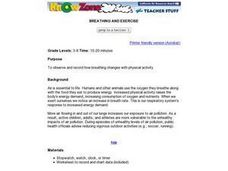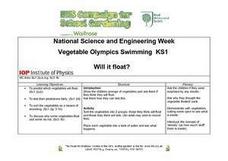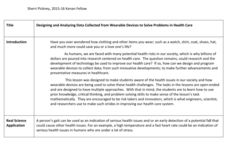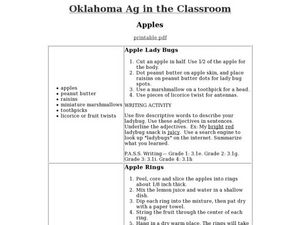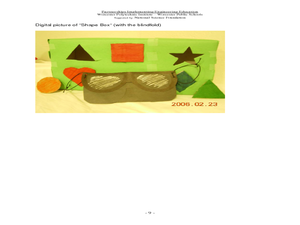Curated OER
Breathing Rates and Exercise
Students work in groups to predict which condition produces more breaths per minute. Groups record their breathing rates during rest periods and periods of activity. They graph their results and make comparisons to their predictions.
Baylor College
Drugs, Risks and the Nervous System
In cooperative groups, middle schoolers contemplate the probability of 18 different situations occurring. After they make predictions, they compare them to the actual risk factors. This eye-opening exercise demonstrates that the odds of...
Baylor College
Body Strength
Your young learners will discover how muscular strength and endurance can increase with this truly hands-on activity! Beginning by writing an acrostic for the word strength, class members then engage in tracking their ability to squeeze...
Curated OER
Which Side to Choose? An Exercise in Choices and Ethics
Students evaluate their reaction to a series of statements to investigate that personal choices are based on personal goals, peer and social pressures, ethic and religious beliefs, and the knowledge of biological consequences. This is...
Scholasic
The Magic School Bus and the Missing Tooth
We chew with our teeth every day, but how much do we really know about them? Allow Ms. Frizzle to teach your kids a thing or two about teeth. Kids complete a prereading exercise, read the book, and respond to several prompts about the...
Curated OER
UV Rays, sunscreen effectiveness
Students identify and define that invisible UV rays can be harmful. Then they explore the effects of UV radiation on objects that react UV rays and what products are most effective in blocking UV rays. Students also make predictions...
Curated OER
How Quickly Disease Spreads
Students demonstrate how quickly disease spreads and the importance of protective measures with communicable diseases. They examine past epidemics such as the Bubonic Plague and make predictions about future epidemics.They compare and...
Curated OER
Pollution in the Air and the Water Pollution Solution
Students explore air pollution. In this ecology and air pollution lesson, students perform an experiment in which a Vaseline coated lid is placed inside and outside the classroom. Students make predictions and then record what they see...
Curated OER
Food for Spaceflight
When astronauts get hungry in outer space, they can't just call and have a pizza delivered. In order to gain an appreciation for the challenges associated with space travel, young learners are given the task of selecting,...
Curated OER
Vegetable Olympic Swimming: Will it Float?
Students inspect nutrition by conducting a science experiment in class. In this vegetable identification lesson, students examine a group of different veggies and predict whether they will sink or float in a tub of water. Students check...
PBS
Stories of Painkiller Addiction: Contemplating Nature vs. Nurture
Does having an addict in your family make it more likely to become one yourself? Explore the genetic risk factors, as well as the prominent environmental influences, for substance addiction in a lesson that encourages awareness and open...
Kenan Fellows
Designing and Analyzing Data Collected from Wearable Devices to Solve Problems in Health Care
Wearable devices have become more the norm than the exception. Learners analyze data from a sample device with a regression analysis in a helpful hands-on lesson. Their focus is to determine if there is a connection between temperature...
Curated OER
Exercise and Water
Second graders discover the needs of their body by trying different types of aerobic exercise. In this physical education lesson, 2nd graders analyze The Busy Body Book by glancing at the pictures inside and predicting what the...
Curated OER
Sports Participation
Students research statistics about sports participation in references such as the Statistical Abstract of the United States. They make and analyze a list of the 10 sports that the highest number of Americans participated in on an amateur...
Curated OER
Drug Addition Is a Disease. So What Do WE Do About It?
Students make predictions about the success rate for treatment of addiction compared with treatment for other chronic diseases. They evaluate case studies of individuals with different diseases to compare and contrast how the diseases...
Curated OER
How Does our Heart Rate Change?
Students feel their pulse and describe it. They predict whether certain activities will increase or decrease their heart rates. Students use a heart rate sensor to determine resting heart rates and those after activity. In conclusion,...
Curated OER
Apples
Second graders complete many cross categorical activities about apples. In this apples lesson plan, 2nd graders cook with apples, make a mobile, finger-paint, write a story about apples, and more. Students read poetry and complete math...
Curated OER
Petri-fied of Bacteria
Students examine the existence of bacteria all around them and consider the roles, both positive and negative, that bacteria play. Over a period of several days, students conduct an experiment in which they predict, determine, log, and...
Curated OER
The Five Senses
Study various objects and help kindergarteners use their five senses to classify the objects. They are presented with various objects and then use their five senses to sort and classify the objects. Then they use a Visual Ranking Tool to...
Curated OER
Recognizing the Importance of Sight
Learners discover the true value of their senses. In this sight instructional activity, students discover the difficulty of life without sight by performing everyday activities without the help of their eyes. The learners examine their...
Space Race
Sensory Detectives
Test your learners' sensory awareness with three hands-on activities that ask pupils to use their other senses to identify and describe everyday objects hidden from sight.
Curated OER
Wellness and the Benefits of Exercise
Second graders discuss benefits of keeping physically fit, predict effects of exercise on their bodies, perform various exercises correctly, including push-up, curl-up, and jumping jack, discuss and follow safety practices while...
Curated OER
Ethical Decision Making in Biology
Young scholars explore a model that illustrates the spread of HIV through an adolescent population. Acting in the role of epidemiologists, students explore the dilemmas of HIV infection presented by a simulation. Young scholars produce a...
Curated OER
The Human Organism
In this digestion and nutrition lesson, 3rd graders test foods to find their vitamin content. Students test for starch and fats then compare their findings on charts and oral reports. The lesson concludes with a teacher directed...
